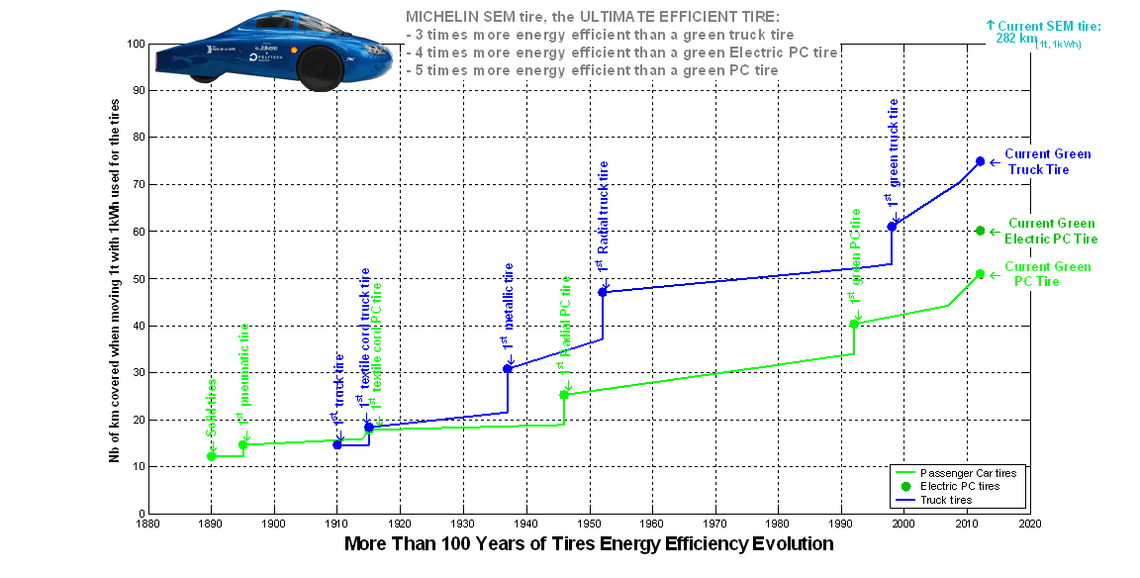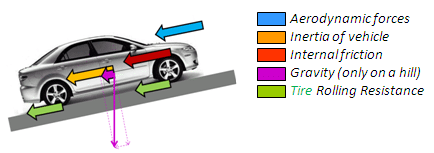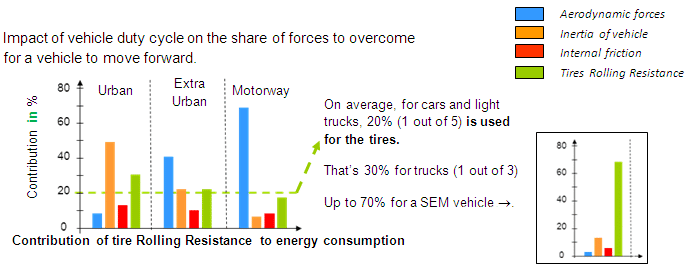ULTIMATE ENERGY TIRE
1 tank out of 5 is used for the tires on PC vehicles, 1 out of 3 for trucks... and much more for a Shell Eco-marathon vehicle, up to 70%!
For the Shell Eco-marathon, Michelin has developed the ultimate energy-efficient tires that are 5 times more energy-efficient than the best tires available for standard passenger cars.
MICHELIN HAS BEEN IMPROVING ENERGY EFFICIENCY FOR MORE THAN 100 YEARS

ENERGY EFFICIENCY AND TIRE ROLLING RESISTANCE
Energy efficiency that means tire rolling resistance reduction.
Rolling resistance
Tire rolling resistance is primarily linked to the deformation of the tire while rolling.

The rolling resistance is one of the forces (in daN) which opposes the motion of the vehicle.

Resisting forces that opposes to the vehicle motion others than the ones due to tires
La force aérodynamique ou trainée est donnée par Fx = ½ ρ V² S Cx avec :
ρ = air volumic mass (in kg/m3)
V = vehicle speed (in m/s)
S = vehicle front surface (in m2)
Cx = drag coefficient
The Cd values for a PC car is around 0.3 (0.38 for a SUV). To optimize it, aerodynamics studies have to be lead in 3D fluid mechanics computing and wind tunnel testings.
Inertia forces are linked to the vehicle mass. Frictions could be reduced in optimizing the mechanical transmissions and using lubricants.
Gravitational forces Fg only apply when the road is inclined. The greater the gradient and vehicle mass, the greater the gravitational forces.
Fg = M g sin α
Where M is the vehicle mass in kg, g the gravitational acceleration (9.81 m/s2), α the angle of the gradient.
Contribution of tire Rolling Resistance to energy consumption

Tire rolling resistance and rolling resistance coefficient
The tire Rolling Resistance coefficient (CRR), is the force of RRt (FRR) divided by the load (FZ). The coefficient is expressed in kg/t. A tire with a rolling resistance coefficient of 10kg/t is the equivalent of a car which is permanently going up a slope with a 1% gradient.
The tire rolling resistance (FRR) is equal to the coefficient RRt (CRR) multiplied by the load carried by the tires (FZ).
FRR = CRR x FZ
TIRE ROLLING RESISTANCE AND ENERGY
The vehicle, in order to counter the rolling resistance of the tires, uses energy. If the vehicle was "perfect" (engine performance at 100%, no aerodynamic drag, no internal friction (due to hub, differential and brake pads), no inertia or energy recuperation, etc.), the contribution of the tire in the consumption would be 100%.
The Shell Eco-marathon participating team "La Joliverie", on their Shell Eco-marathon Urban Concept "CityJoule", successed in lowering the Cx less than 0.1, in reducing the vehicle weight down to 83 kg, reducing the losses due to friction. The contribution of the tire in the consumption of this vehicle is close to 70%!
More information about Energy consumed due to tire rolling resistance
The energy expended by the tire (E) is the product of the force owing to the rolling resistance (FRR) by the distance covered (d).
E = FRR x d and FRR = CRR x FZ therefore:
E = CRR x FZ x d
Based on this formula, we can talk about the energy efficiency of the tire by comparing the distances travelled by a vehicle (perfect) for a given quantity of energy (it is advisable to take the kWh).
d = E / ( CRR x FZ ), 1 kWh = 3 600 000 J, 1 J = 1 Nm, FZ = M x g, therefore:
d (km) = 3 600 000 / (CRR(kg/t) x M(kg) x 9.81)
So, if you compare an Urban Concept tire with a MICHELIN Energy Saver tire + (of identical weight):
Crr in kg/t | Weight of vehicule + driver in kg | # km for 1 kWh | |
|---|---|---|---|
MICHELIN Urban Concept | 1.3 | 160 | 1764 |
MICHELIN Energie Saver+ | 8 | 160 | 287 |
A MICHELIN Urban Concept tire is approximately 6 times more efficient than one of the best energy efficient tires on the market.
If you compare its usage with the respective weights of the vehicles (considered to be perfect):
Crr in kg/t | Weight of vehicule + driver in kg | # km for 1 kWh | |
|---|---|---|---|
Urban Concept fitted with MICHELIN SEM tires | 1.3 | 160 | 1764 |
City car fitted with MICHELIN Energie Saver+ | 8 | 1500 | 31 |
An Urban Concept vehicle with MICHELIN Shell Eco-marathon tires is approximately 57 times more efficient than a vehicle fitted with the best energy efficient tires on the market.
Hence the interest to car makers to make their vehicles lighter in order to reduce energy consumption, to either reduce CO2 emissions or increase the autonomy of the electric vehicle.
For the last example, you can also say that every 31 km, you need to inject 1kWh to counter the rolling resistance of the tires of the city car chosen.
NB :
1 liter petrol (gas) | 1 liter diesel | |
|---|---|---|
Energetic content of fuels | 9.12 kWh | 9.97 kWh |
CO₂ emission of fuels | 2.35kg of CO₂ | 2.65kg of CO₂ |
Importance of the tire pressure
To reach the better energy efficiency level of a tire, the recommended inflating pressure has to be respected.
The advised pressures for the Shell Eco-marathon tires are 700 kPa for 45/75R16 prototype tires and 500 kPa for 95/80R16 urban concept tires. Of course, depending on the vehicle settings, this could vary a little.
Influence of a bad tire pressure
The direction of the arrows indicates an improvement or degradation of the performance. This is why it is so important to adhere to the advised pressures.
Performance | Under inflated | Over inflated | Comment |
|---|---|---|---|
Grip on low water level | ↗ | ↘ | Effect on the surface of the content patch |
Grip on high water level | ↘ | ↗ | Bow effect |
Endurance | ↘ | ↗ | Less deformation |
Longevity | ↘ | ↘ | Abnormal wear |
Comfort | ↗ | ↘ | Less vertical stiffness |
Handling | ↘ | ↘ | Tire-vehicule tuning |
Fuel saving | ↘ | ↗ | Less deformation |
Acoustic comfort (interior noise) | ↘ or ↗ | ↘ | Tire-vehicule tuning |
This is why it is so important to adhere to the advised pressures.
Ultimate energy tire
Thanks to the specific usage of low weight and speed, the rolling resistance could have been drastically reduced down to around 1.3 kg/t, thus 5 times more energy efficient than the best energy efficient tire we can find on the market, while maintaining a high level of other expected performances.
That's what we call MICHELIN Total Performance, more performances simultaneously brought together thanks to Michelin leading technologies.
The shape of the tires herald the future of the tire: tall and narrow.